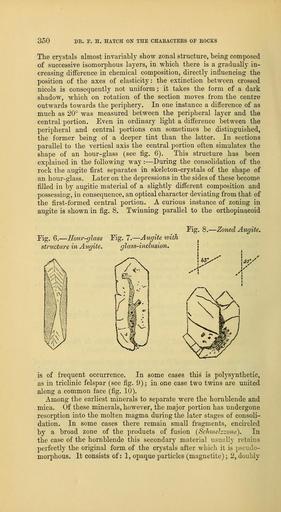MAKE A MEME
View Large Image

| View Original: | The_Quarterly_journal_of_the_Geological_Society_of_London_(13937220822).jpg (1154x2105) | |||
| Download: | Original | Medium | Small | Thumb |
| Courtesy of: | commons.wikimedia.org | More Like This | ||
| Keywords: The Quarterly journal of the Geological Society of London (13937220822).jpg 352 DE F H HATCH ON THE CHARACTERS OF ROCKS <br> sections present the cross- jointing parallel to the basal plane and the <br> central accumulation of inclusions in the direction of the vertical axis <br> characteristic for apatite The mineralogical composition of the <br> rock is that of an augite-andesite ; but its structure is basaltic <br> the felspar being confined to the ground-mass while the augite is <br> porphyritic With the exception of the absence of olivine it differs <br> in no essential respect from the basalt described in section b <br> d Basalt with Hornblende as a Constituent of the Ground-mass <br> The rock placed under this head is a basalt of rather unusual <br> type It occurs in one of a series of dykes on the sea-coast at Am- <br> bodimadiro on the north-west coast Originally vesicular its cavities <br> have become infilled with fibrous zeolites and calcite The powdered <br> rock effervesces strongly with hydrochloric acid ; and on standing in <br> the cold gelatinous silica separates No cubes of salt being formed <br> in the solution when evaporated the zeolites must be lime-zeolites <br> scolecite phillipsite <br> The chief porphyritic constituent of the rock is augite in nu- <br> merous large and well-shaped crystals which are partially invaded <br> by serpentinous and calcareous alteration-products Plagioclase also <br> occurs porphyritically ; but its crystals are few and small <br> The ground-mass is a plexus of felspar-laths between which are <br> scattered numerous small crystals and needles of brown hornblende <br> and granules of magnetic iron-ore Interstitial glassy matter <br> could not be detected <br> In its general character the rock much resembles a tephrite and an <br> attempt was made to prove the presence of nepheline But the fact <br> that the hydrochloric-acid solution of the powdered rock gave no <br> cubes of salt tends to negative this supposition After etching and <br> treatment with fuchsine however a number of small specks retained <br> the colour ; and it is quite possible that these may be granules of <br> nepheline <br> It is an interesting fact with regard to this rock that while augite <br> appears as a porphyritic constituent hornblende is present only <br> in the ground-mass thus reversing the usual order of things <br> The occurrence of hornblende as a constituent of the ground-mass <br> of basalts has been mentioned by C Chelius <br> e Felspar-free Basalt Magma-basalt Boiicky <br> Belonging to this class is a black compact semi-vitreous rock <br> from a lava-stream near the village of Ambohipolo in the volcanic <br> region to the west of Lake Itasy <br> In thin section this rock appears as a clear brown glass containing <br> numerous microlites and crystals of augite and magnetite the <br> latter in square and lozenge-shaped sections varying in diameter <br> from -006 mm to -086 mm Olivine is rare The augite is pale <br> ' Erlautervmgen zu Blatt Messel und Blatt Eossclorf der geolog Karte <br> des Grossk Hessen ' Darmstadt 1886 Eosenbusch Die massigen Gest <br> vol ii p 711 36940165 113696 51125 Page 350 Text 45 http //www biodiversitylibrary org/page/36940165 1889 Geological Society of London Biodiversity Heritage Library The Quarterly journal of the Geological Society of London v 45 1889 Geology Periodicals Smithsonian Libraries bhl page 36940165 dc identifier http //biodiversitylibrary org/page/36940165 smithsonian libraries Information field Flickr posted date ISOdate 2014-04-21 Check categories 2015 August 26 CC-BY-2 0 BioDivLibrary https //flickr com/photos/61021753 N02/13937220822 2015-08-26 05 50 58 cc-by-2 0 PD-old-70-1923 The Quarterly journal of the Geological Society of London 1889 Photos uploaded from Flickr by Fæ using a script | ||||